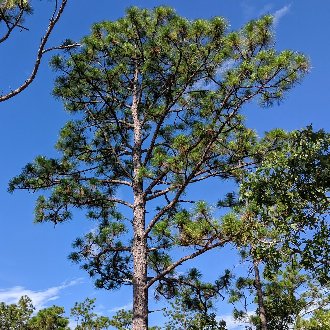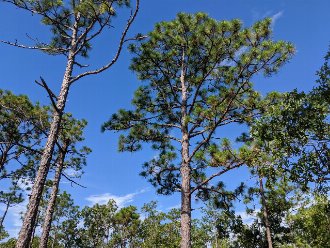Longleaf Pine (Pinus palustris Mill.)
↑Summary
A long-lived, fire-adapted species of pine native to the southeastern U.S., and the largest of the southern pine species, the longleaf pine has declined due to a combination of heavy harvesting for timber, slow natural regeneration, and fire suppression.
↑Range - Expand
| Legend | Color |
| Native or Not Present | |
| Native | |
| Native or Expanded |
This tentative map is based on our own research. It may have limited data on Canada and/or Mexico, and there is some subjectivity in our assignment of plants as introduced vs. expanded. Read more in this blog post.
Although this plant occurs somewhere in each of these regions, it may only occur in a small part of some or all of them.
↑Similar Plants
↑Habitat
Longleaf pine historically was the dominant tree on savannas of the southeastern United States, particularly the Southern Coastal Plain and also significant areas of the Southeastern Plains, where it was the only canopy dominant on many sites, and formed an open canopy. It depends on fire for survival, and is strictly limited to climates in the southeast where there is a combination of a high frequency of lightning strikes during the growing season, and a dry season in late spring where periods of many days without rain coincide with occasional storms that bring numerous lightning strikes.
It is typically found on deep, coarse sandy soils low in nutrients and poor at holding water. Mostly found at low elevations, below 660ft (200m) but can be found up to about 1970 feet (600m.)
This species significantly influences the habitats in which it grows, contributing to the conditions it needs to persist long-term through tall tree trunks (either living or dead) encouraging lightning strikes, and through flammable resins encouraging ignition following a lightning strike. The pines, however, do not provide the bulk of the fuel for fires, instead relying on fuel provided by ground-level herbaceous vegetation.
Habitat for this species has been drastically reduced by fire suppression, which is related to development of land for agriculture, forestry, or urban/suburban use. These changes have been so severe that they have resulted in this species, once dominant over huge areas, becoming endangered. Its habitat is also threatened by invasive species including cogongrass (Imperata cylindrica), kudzu (Pueraria montana), and shrub lespedeza (Lespedeza bicolor).
↑Life Cycle
Seeds germinate within a couple weeks of falling, and require exposed mineral soil to germinate. Seedlings spend their early years, usually at least 2 but as long as 20, in a "grass stage", where the plant has no stem and superficially resembles a grass. During this time, the plant establishes an extensive root system. Once sufficient roots are established, the the plant begins growing upright, often faster than 3ft / 1m per year. The tree initially grows with a single trunk and does not typically branch until about 10 to 16 feet (3-5 m) in height.
This unusual growth pattern is an adaptation to the severe fires found in this species' habitat. Seedlings in the grass stage are able to resprout vegetatively, but upright trees are not as able to resprout. Mature trees, on the other hand, are able to survive all but the most severe fires through their insulated bark. However, saplings are vulnerable to top-kill. By delaying upright growth until the plant has stored up a large amount of energy and built an extensive root system, and then maturing very rapidly, individuals are able to minimize their risk of top-kill by fire by shortening the time period where they are vulnerable.
Trees begin producing cones at about 30 years of age. Trees have a two-tier masting cycle, in which there is a heavy seed crop every 7 to 10 years, and a moderate seed crop every 3-4 years.
Established trees can live 400-500 years; they tend to be windfirm and resistant to insects, and healthy trees are rarely harmed by insects or hurricanes. Trees can be killed by severe fires following a period of extreme drought. In habitats still allowed to burn, dead trees often remain standing for years, functioning as lightning rods that help to ignite fires and maintain the habitat for future generations of trees.
In the absence of fire, trees, especially ones not of canopy height, can also be killed by competition from more shade-tolerant vegetation.
↑Uses
The wood of this species is among the most desirable types of pine, valued for its straight wood with few defects. Its wood is considered similar to other southern yellow pines, but often the most desirable among them.
↑Links & External Resources
• Longleaf Pine | The Wood Database (About This Site)
• Longleaf Pine | Fire Effects Information System (FEIS) (About This Site)
• Pinus palustris (Longleaf Pine) | USDA PLANTS Database (About This Site)
• Longleaf Pine | Virginia Tech Dendrology Factsheets (About This Site)
• Longleaf Pine | Silvics of North America (About This Site)
• Pinus palustris | Biota of North America Project (BONAP) (About This Site)
• Pinus palustris | NatureServe Explorer (About This Site)
• Pinus palustris | Flora of North America (About This Site)
• Longleaf Pine | Maryland Biodiversity Project (About This Site)
• Pinus palustris Miller (Longleaf Pine) | Digital Atlas of the Virginia Flora (About This Site)









